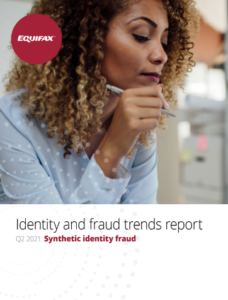Fight Fraud in Digital Transactions
Necessity is the mother of invention.
Just ask banking, fintech, and retail businesses, many of which compressed a decade of e-commerce innovation into less than a year. This helped consumers move from in-person transactions to touchless, digital platforms during the COVID-19 pandemic.
However, another group has been working quietly behind the scenes during this time, fraudsters. As businesses and consumers shift to online, fraudsters are also innovating and inventing new ways to exploit vulnerabilities and opportunities. Below are notable observations with respect to fraud, along with a fresh approach to offering meaningful digital experiences to mitigate fraud.
Fraud trends are evolving, fast.
It’s 2021 and three words are keeping business executives awake at night, synthetic identity fraud. This is when criminals combine bits and pieces of real and made-up identities to form a new “synthetic” identity. In print or on a computer screen, they look like real identities. Which makes fraudsters incredibly difficult to detect.
Up to 70 percent of fraud executives participating in a recent Aite Group study believe synthetic identity fraud is a bigger challenge than identity theft.¹ What’s more, the latest Equifax Identity and Fraud Trends report reveals that fraud trends associated with synthetic identities are on the rise.
Credit piggybacking among suspicious synthetic identities is up 40 percent from 2019 through early 2021. Credit piggybacking is when
 fraudsters use information from legitimate, good standing account holders. This can manifest into credit boosting schemes tied to credit repair and other fraud types. While not all piggybacking is fraud, it can point to an increased potential for fraud. Criminals are looking for ways to activate synthetic identities.
fraudsters use information from legitimate, good standing account holders. This can manifest into credit boosting schemes tied to credit repair and other fraud types. While not all piggybacking is fraud, it can point to an increased potential for fraud. Criminals are looking for ways to activate synthetic identities.Authorized user velocity risk has increased 26 percent from January 2018 through January 2021. Authorized user abuse occurs when a synthetic identity fraudster pays a primary account holder to become an authorized user on their good account. User velocity risk occurs when organized crime rings continually add synthetic identities to credit cards as authorized users over time.
Roughly 1.8 million consumer credit accounts were identified as potential synthetic identity fraud within the time span of one year in a recent Equifax internal analysis.
One out of every three false positives identified by Equifax is actually a synthetic identity.
Enter: the customer experience.
Given the rapid adoption of e-commerce, consumer expectations around their online transaction and security experiences have skyrocketed. To put it simply, they’re empowered thanks to an unprecedented number of ways to shop and finance purchases. If they make the time and effort to engage with a digital platform, they expect an instant, easy experience or, oftentimes, they will quickly move on. That means there's zero room for increased friction due to fraud mitigation. This applies to all experiences across the customer journey including sales, account management, customer service, credit origination, and more.
Anything "extra" in the form of one-too-many data entry fields or security questions, or a slow approval process due to a false-positive review, can drive customers away. Their online experience should be better—more convenient and more secure—than the perceived safety of an in-person transaction. That way, they’re more likely to complete the transaction and return for future transactions.
The power play: build digital identity trust.
To win the battle against fraud—no matter where it occurs in the customer journey—and deliver a seamless online customer experience, businesses must be able to trust the faceless identities they’re engaging with online.
This means they need the ability to do two things.
First, they need to bring together a mix of identity data and signals that reveal relevant past interactions, present context, and predicted intent.
Second, they need the ability to automatically analyze and cross-reference that information behind the scenes. This establishes “trust” in the digital identity that’s being presented. It’s an approach known as digital identity trust.
Identity trust helps ensure the user trying to log in to a banking app is an authorized account holder—not a fraudster who hacked or stole the information. Or, say a retail customer is attempting to checkout online as a “guest.” Identity trust comprehensively cross-references and validates their identity including their device information, in real time, without adding friction that might cause a legitimate customer to abandon their cart.
As more transactions move to digital, and at a higher frequency, customer relationships are being tested and challenged with every interaction. It’s necessitating an inventive new framework for managing consumer engagement and fraud mitigation. The power play is bringing all available identity data and signals together. This not only minimizes fraud but to enhances the consumer experience across their online customer journey.
Learn the basics of digital identity trust including the specific types of data and signals used, and how those insights work together to help predict the likelihood of fraud in seconds, in this information-packed white paper, Identity Trust — Your frontline defense in the battle against fraud: catch fraud at the front door, while facilitating secure, seamless consumer interactions. VIEW NOW
Also, take a minute to view the latest Equifax Identity and Fraud Trends Reports, where you’ll find year-over-year statistics (including 2021) on synthetic identity fraud and read the latest fraud-detection insights from top data science and analytics experts. DOWNLOAD REPORT
1 Synthetic Identity Fraud: Diabolical Charge-Offs on the Rise | Aite Group
Recommended for you

